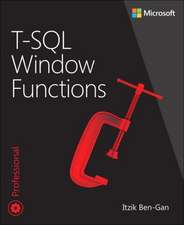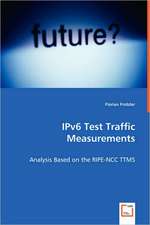T-SQL Fundamentals: Developer Reference
Autor Itzik Ben-Ganen Limba Engleză Paperback – 3 aug 2016
- Work with programming practices unique to T-SQL
- Create database tables and define data integrity
- Query multiple tables using joins and subqueries
- Simplify code and improve maintainability with table expressions
- Implement insert, update, delete, and merge data modification strategies
- Tackle advanced techniques such as window functions, pivoting and grouping sets
- Control data consistency using isolation levels, and mitigate deadlocks and blocking
- Take T-SQL to the next level with programmable objects
Preț: 232.13 lei
Preț vechi: 290.17 lei
-20% Nou
44.42€ • 46.21$ • 36.67£
Disponibil
Livrare economică 24 martie-07 aprilie
Livrare express 07-13 martie pentru 42.98 lei
Specificații
ISBN-10: 150930200X
Pagini: 512
Dimensiuni: 185 x 224 x 28 mm
Greutate: 0.77 kg
Ediția:3
Editura: Microsoft Press
Seria Developer Reference
Notă biografică
TZIK BEN-GAN is a mentor with and co-founder of SolidQ. A Microsoft Data Platform MVP since 1999, Itzik has taught numerous training events around the world focused on T-SQL querying, query tuning, and programming. Itzik is the author of several books about T-SQL. He has written many articles for SQL Server Pro as well as articles and white papers for MSDN and The SolidQ Journal. Itzik's speaking engagements include Tech-Ed, SQL PASS, SQL Server Connections, presentations to various SQL Server user groups, and SolidQ events.
Itzik is a subject-matter expert within SolidQ for its T-SQL related activities. He authored SolidQ's Advanced T-SQL and T-SQL Fundamentals courses and delivers them regularly worldwide. You can learn more about Itzik at http://tsql.solidq.com/.
Cuprins
CHAPTER 1 Background to T-SQL querying and programming
CHAPTER 2 Single-table queries
CHAPTER 3 Joins
CHAPTER 4 Subqueries
CHAPTER 5 Table expressions
CHAPTER 6 Set operators
CHAPTER 7 Beyond the fundamentals of querying
CHAPTER 8 Data modification
CHAPTER 9 Temporal tables
CHAPTER 10 Transactions and concurrency
CHAPTER 11 Programmable objects
Appendix: Getting started
Index





























